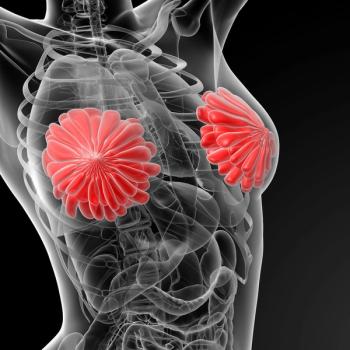
- ONCOLOGY Vol 20 No 3
- Volume 20
- Issue 3
Non-BRCA Hereditary Breast Cancer Linked to New Cancers
The risk for a new cancer in the unaffected breast substantially increases in women diagnosed with unilateral, hereditary (non-BRCA) breast cancer, according to a new study. Published in the March 15, 2006, issue of Cancer, the study reveals that women under age 50 diagnosed with hereditary (non-BRCA) breast cancer are at significantly greater risk for developing cancer in the other breast. Adjuvant hormonal therapy, however, reduces contralateral breast cancer risk.
The risk for a new cancer in the unaffected breast substantially increases in women diagnosed with unilateral, hereditary (non-BRCA) breast cancer, according to a new study. Published in the March 15, 2006, issue of Cancer, the study reveals that women under age 50 diagnosed with hereditary (non-BRCA) breast cancer are at significantly greater risk for developing cancer in the other breast. Adjuvant hormonal therapy, however, reduces contralateral breast cancer risk.
Women with hereditary (non-BRCA) breast cancer are estimated to be at up to six times greater risk of developing a second primary malignancy in the other breast than the general population is of developing primary breast cancer. Young age at first diagnosis, family history of breast cancer, and confirmed BRCA1 or BRCA2 gene mutations are the primary risk factors for contralateral breast cancer. However, the contribution of non-BRCA hereditary cancers to the risk of contralateral breast cancers is poorly understood.
Led by Katarina Shahedi, md, of the Umeå University and colleagues at the Karolinska Institute in Stockholm, Sweden, researchers reviewed data from 120 families and 204 women with unilateral breast cancer and a family history of breast cancer but no BRCA mutations to better characterize the contralateral breast cancer risk for these women.
Swedish Study Results
Dr. Shahedi’s team found that long-term contralateral breast cancer risk was significantly higher in women with hereditary breast cancer compared to the risk of developing a primary breast cancer in the general population. The overall probability for these women was 5.5% at 5 years and up to 27.3% at 20 years compared to only 1.9% at 5 years and 4.9% at 20 years for the general population. Further analysis by age group showed clearly that the 15-year probability of developing a contralateral breast cancer was significantly elevated for women under age 50 years compared to women over age 50 (40% and 10%, respectively).
Women who took adjuvant hormonal therapy had a significantly lowered risk for a contralateral breast cancer compared to those who did not take it. Adjuvant chemotherapy had no apparent effect on risk.
In the first published study to characterize contralateral breast cancer risk in non-BRCA hereditary breast cancers, the authors demonstrate “that women with hereditary/familial non-BRCA1/BRCA2 breast cancer have a very high risk of developing [cancer in the other breast].” The impact of these results is most apparent for premenopausal women, of whom 1 in 5 will develop contralateral breast cancer after only 10 years. Consequently, conclude the authors, “it is important to consider and provide information about [this risk].”
Articles in this issue
almost 20 years ago
Report Finds Historic Drop in Total Number of Cancer Deathsalmost 20 years ago
Treating the Troops: A Model for Battling Health-Care Disparitiesalmost 20 years ago
FDA Grants Fast-Track Designation to ZD6474 for Thyroid Canceralmost 20 years ago
NIH Launches Comprehensive Effort to Explore Cancer Genomicsalmost 20 years ago
New Oral Agent Approved for Kidney Cancer and GISTalmost 20 years ago
Rituxan Plus CHOP Approved for Diffuse Large B-Cell Lymphomaalmost 20 years ago
Identification and Treatment of Aggressive Thyroid Cancers (Part 1)almost 20 years ago
Commentary (Munarriz): Sexual Health Issues in Men With CancerNewsletter
Stay up to date on recent advances in the multidisciplinary approach to cancer.


















































































